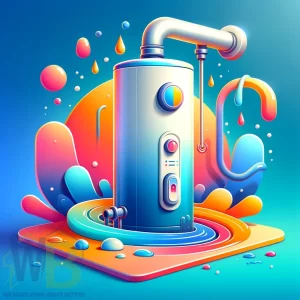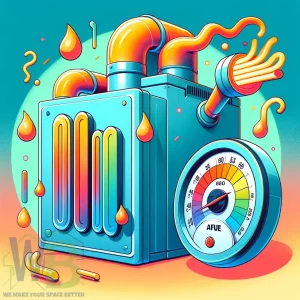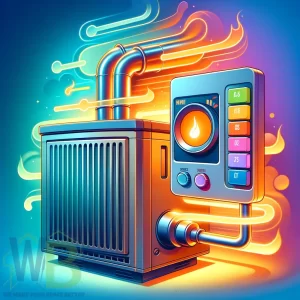An HVAC system keeps our homes comfortable throughout the year. HVAC stands for Heating, Ventilation, and Air Conditioning. This system has several key parts.
Each HVAC part plays an important role. Understanding these parts and components can help us appreciate how the system works.
An HVAC system has several components. These include the thermostat, condensing unit, and more. Each part has a specific job.
Together, they ensure your home stays comfortable. The following sections will examine each component to explain their roles and functions.

Quick Summary
| –Component– | –Function– | –Key Points– |
|---|---|---|
| Thermostat | Regulates temperature | – Senses temperature – Controls heating/cooling units |
| Condensing Unit | Releases heat outdoors | – Contains compressor, coil, blower, fan |
| Heat Exchanger | Transfers heat between fluids | – Found in furnaces, ACs – Types: shell and tube, plate, air-to-air |
| Refrigerant Lines | Carry refrigerant | – Types: insulated, uninsulated – Materials: copper, aluminum |
| Furnace and Blower Motor | Heats and circulates air | – Furnace heats air – Blower motor distributes air |
| Ductwork | Distributes air throughout the home | – Types: supply, return – Made of durable materials |
| Return and Supply Registers | Allow air to enter/leave the system | – Supply: distribute air – Return: pull air back |
| Evaporator Coil | Absorbs heat from indoor air | – Removes moisture – Works with condenser coil |
Thermostat

The thermostat is a key part of an HVAC system. It’s like the system’s brain. It senses the temperature and tells the heating or cooling units what to do.
This helps maintain the temperature you want in your home. Thermostats are used in many places, like homes, offices, and even in fridges and ovens.
What Makes Up a Thermostat?
A thermostat has several important parts:
- Frame and Housing: This includes a valve connected to a piston.
- Flange: Found in the thermostat’s body.
- Spring: This shuts the valve when the coolant isn’t hot.
- Wax Element: Also known as the core of the thermostat, it’s key in controlling temperature.
Types of Thermostats
There are different kinds of thermostats:
- Conventional Thermostats: These use a spring and have alcohol inside. They move when the coolant gets hot.
- Wax-type Thermostats: Their main part is wax that expands with heat and is in contact with the coolant.
The Thermostat in HVAC Systems
The thermostat’s job in HVAC systems is to control heating or cooling. It shows the current temperature and lets you set your preferred one. When your home reaches this temperature, the thermostat keeps checking the air.
If needed, it turns the system back on. Some thermostats can even be set to change the temperature at different times of the day. Plus, certain thermostats can control the humidity in your home, but they need special equipment to do this.
Condensing Unit

The condensing unit is crucial to your home’s air conditioning system. It’s typically located outside. Its main job is to get rid of the heat that’s taken from inside your home. This unit has several parts that work together to keep your home cool.
Key Parts of a Condensing Unit
Here are the main components of a condensing unit:
- Coil: Known as the condenser coil, this acts as a heat exchanger. It releases the indoor heat to the outside.
- Compressor: This is like the heart of the unit. It moves the refrigerant gas between the evaporator and condensing coils.
- Blower: Works with a fan to move air over the unit, helping eliminate the heat.
- Fan: Linked to the blower, it helps move air over the unit when it works.
- Expansion Valve: A small but important part. It controls how much refrigerant goes to the unit, ensuring the system has the right amount.
Maintaining Your Condensing Unit
Understanding these parts is helpful for homeowners. It can help you keep your system in good shape and fix problems.
This includes checking for refrigerant leaks, keeping the unit clean, and ensuring it’s well-lubricated. These steps can make your condensing unit last longer and work better.
Heat Exchanger

A heat exchanger is like a bridge for heat transfer in HVAC systems. It moves heat between fluids, usually without mixing them. This part is vital in furnaces, air conditioners, and refrigerators.
Main Parts of a Heat Exchanger
Here’s what makes up a heat exchanger:
- Tubes: These are pathways for fluids, allowing heat to move between them.
- Fins: Attached to the tubes, fins increase the area for heat transfer, making the exchanger more efficient.
- Frame: This supports the tubes and fins, giving the exchanger structure.
- Seals: They prevent fluid leaks and maintain the correct pressure for heat transfer.
Types of Heat Exchangers
Heat exchangers come in different forms, depending on their design and use:
- Shell and Tube: The most common type. It has tubes for one fluid inside a larger shell with another fluid. Heat moves through the tube walls.
- Plate Heat Exchangers: These have a series of plates with special surfaces. Fluids flow through these plates, transferring heat.
- Air-to-Air: These transfer heat between two air streams. They’re often used in ventilation to reuse heat from exhaust air.
Keeping Your Heat Exchanger in Shape
Knowing about heat exchangers helps in maintaining your HVAC system. Regular checks, like cleaning to remove dirt, can extend its life and improve efficiency.
Refrigerant Lines

Refrigerant lines are like the highways of an HVAC system. They’re narrow metal tubes that move refrigerant gas. This gas travels between the condensing unit and the evaporator coil. These lines are key in heating and cooling your home, as they carry the refrigerant that transfers heat inside and outside.
Two Main Types of Refrigerant Lines
Refrigerant lines come in two forms:
- Insulated Lines: These have a layer of insulation. This reduces heat loss to the surroundings and makes your HVAC system more efficient.
- Uninsulated Lines: These don’t have insulation. They are used where the temperature difference between the refrigerant and the environment isn’t a big deal.
Materials of Refrigerant Lines
The lines are usually made from materials like copper or aluminum. These materials are chosen because they handle heat and cold well.
Maintaining Refrigerant Lines
Taking care of these lines is important. Regular checks for leaks and ensuring they are properly insulated help your HVAC system work better and last longer.
Furnace and Blower Motor

The furnace and blower motor are essential in a home’s HVAC system. They work together to heat and circulate air throughout your home.
The Furnace: Heating the Air
The furnace’s job is to heat the air. It uses fuel like natural gas, oil, or electricity for this. Inside the furnace, there’s a heat exchanger. This part transfers the heat from the fuel to the air.
The Blower Motor: Circulating Warm Air
The blower motor has an important role, too. It moves the heated air through your home’s ductwork. The air comes out through supply registers. It doesn’t stop there, though. The blower motor also brings in cool air from return registers. This cycle keeps your home warm. Additionally, the blower motor helps distribute cool air from the air conditioner.
Importance of Understanding and Maintenance
Knowing how your furnace and blower motor work is useful. It helps you keep them running well. Regular maintenance is key. This includes checking how they work, keeping the furnace clean, and changing air filters when needed. These steps can make your HVAC system more efficient and last longer.
Ductwork

Ductwork is like the network of roads for air in an HVAC system. It’s the path that air takes to travel around your home. Ducts connect your HVAC equipment, like the furnace or air handler, to the supply and return registers in different rooms.
Types of Ductwork
There are two key kinds of ducts in this system:
- Supply Ducts: These carry heated or cooled air from your furnace or air handler into your living spaces. They spread this conditioned air around your home.
- Return Ducts: These ducts return air from your home to the HVAC equipment. Here, the air is reheated or cooled again before being sent back out.
Material of Ductwork
Ducts are usually made from materials that resist heat and cold, like copper or aluminum. This makes them durable and effective.
Importance of Ductwork Maintenance
Knowing about your ductwork helps in taking care of your HVAC system. Regular checks are important. Look for leaks, make sure the insulation is good, and clean the ducts to remove dirt. Doing these things helps your HVAC system work better and last longer.
Return and Supply Registers

Return and supply registers are the gateways for air in an HVAC system. They play a big role in moving heated or cooled air around your home. They also help pull cool air back into the system to be conditioned again.
Supply Registers: Distributing Air
Supply registers are the vents that send heated or cooled air from your HVAC into your rooms. You can usually find them on walls or floors. These registers often have adjustable louvers. These louvers let you direct the airflow where you want it.
Return Registers: Bringing Air Back
Return registers work differently. They draw cool air back into the HVAC system. This air is then reheated or cooled and sent back out. Return registers are typically found on walls. They have a grille to keep dust out of your HVAC system.
Keeping Registers in Good Shape
Understanding these registers helps you take care of your HVAC system. This includes ensuring the registers work correctly, keeping them clean, and changing air filters when needed. These steps help keep your HVAC system efficient and long-lasting.
Evaporator Coil

The evaporator coil is a key part of your air conditioning or heat pump system. It plays a major role in cooling and improving the air inside a building. You’ll find it inside the air handler or attached to the furnace.
Main Functions of an Evaporator Coil
Here’s what the evaporator coil does:
- Absorbing Heat: It contains a cold refrigerant. As air passes over the coil, the refrigerant absorbs heat. This cools down the air inside your building.
- Removing Moisture: The coil also takes moisture out of the air. When air blows over the coil, the moisture turns into water on the coil. Then, it drips into a drain pan. This process helps make the air cooler and more comfortable.
- Working with the Condenser Coil: The evaporator coil works with the condenser coil. Together, they exchange heat to produce cool air. The warm refrigerant from the evaporator goes to the outdoor unit. There, the heat is released into the outside air.
Keeping the Evaporator Coil Healthy
Taking care of the evaporator coil is crucial for your HVAC system’s performance. This includes changing the air filter, cleaning the coil, and ensuring good airflow. These steps help your system stay efficient and last longer.
Wrapping Up: Understanding Your HVAC System
In this article, we explored the essential parts of an HVAC system. Each component, from the thermostat to the evaporator coil, is vital in maintaining a comfortable indoor environment. Understanding these components helps in several ways:
- Better Maintenance: Knowing how each part works allows for more effective maintenance. This can prevent breakdowns and extend the life of your HVAC system.
- Troubleshooting: This knowledge makes identifying and resolving issues more accessible. This can save time and potentially reduce repair costs.
- Enhanced Comfort: Properly maintained parts ensure your HVAC system operates efficiently. This leads to consistent temperatures and better air quality in your home.
Checking components like the furnace, blower motor, and ductwork and ensuring they are in good condition can make a big difference.
Caring for your HVAC system ensures it cares for you, providing comfort year-round.







